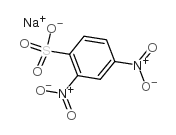Tracking human contact allergens: from mass spectrometric identification of peptide-bound reactive small chemicals to chemical-specific naive human T-cell priming.
Lisa Dietz, Philipp R Esser, Sonja S Schmucker, Irina Goette, Anne Richter, Martina Schnölzer, Stefan F Martin, Hermann-Josef Thierse
Index: Toxicol. Sci. 117(2) , 336-47, (2010)
Full Text: HTML
Abstract
Modification of proteins by reactive small chemicals is a key step in the activation of chemical-specific T cells in allergic contact dermatitis (ACD). However, an integrated approach to characterize both the precise nature of chemically modified proteins and the chemical-specific T cells is currently lacking. Here, we analyze the molecular conditions for adduct formation of the strong human contact sensitizer 2,4-dinitrochlorobenzene (DNCB) and its water-soluble form, 2,4-dinitrobenzenesulfonic acid (DNBS), with both an all amino acid-containing model peptide (± Cys) and the protein human serum albumin (HSA). Mass spectrometric detection and quantification revealed thiol-dependent peptide adduct formation at all pH values found in human skin layers. Highest modification rates were obtained with DNBS. Accordingly, DNBS- but not DNCB-modified human immature dendritic cells (iDC) induced in vitro primary human T-cell responses as did 2,4,6-trinitrobenzenesulfonic acid-modified iDC as measured by dinitrophenyl (DNP)- and trinitrophenyl (TNP)-specific T-cell proliferation and interferon gamma (IFN-γ) production in CD4(+) and CD8(+) T-cell subsets. Moreover, DNP-modified HSA protein effectively induced primary T-cell responses when processed by iDC. Thus, an integrated approach that combines efficient skin-related in chemico coupling analyses with an in vitro T-cell priming assay can be used to predict in vivo reactions of chemical contact allergens with extracellular and cellular proteins. This strategy supports the development of chemical-specific in vitro assays that are urgently required in predictive hazard identification and risk assessment of allergenic and nonallergenic chemicals.
Related Compounds
| Structure | Name/CAS No. | Molecular Formula | Articles |
|---|---|---|---|
 |
Benzenesulfonic acid,2,4-dinitro-, sodium salt (1:1)
CAS:885-62-1 |
C6H3N2NaO7S |
|
Differential recruitment of high affinity A1 and A2A adenosi...
2011-01-15 [Eur. J. Pharmacol. 650(2-3) , 639-49, (2011)] |
|
Erythropoietin reduces the development of experimental infla...
2004-12-01 [J. Pharmacol. Exp. Ther. 311(3) , 1272-80, (2004)] |
|
Brønsted acid catalyzed asymmetric reduction of ketones and ...
2010-05-21 [Org. Lett. 12(10) , 2294-7, (2010)] |
|
Beneficial intervention of experimental colitis by passive c...
2001-01-01 [J. Investig. Med. 49(1) , 21-9, (2001)] |
|
Facile synthesis of colorimetric histone deacetylase substra...
2012-10-04 [Chem. Commun. (Camb.) 48(76) , 9525-7, (2012)] |